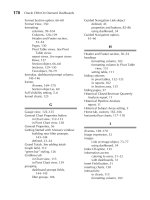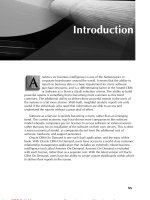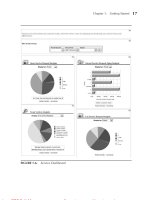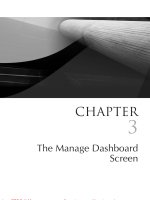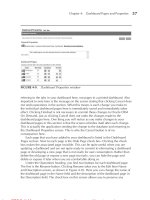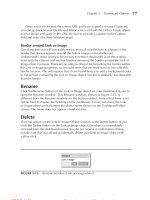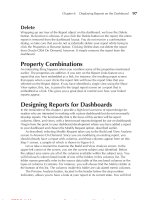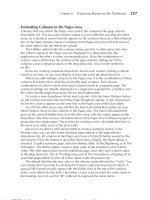CRM On Demand Recommended Practices Integration, The Oracle Advantage phần 2 pps
Bạn đang xem bản rút gọn của tài liệu. Xem và tải ngay bản đầy đủ của tài liệu tại đây (1.06 MB, 10 trang )
business IT infrastructure.
Organizations that have or plan to develop a clear middleware integration strategy are able to maximize their
investment by further adopting the following approach:
Define systems that will become the record of
source. This does not have to be a system for all
records, in many businesses product mastering may
be in a different system to customer mastering.
Ensure the most appropriate systems are in control
of key data. A CRM system is ideal for managing
customer information, but is not a suitable
platform for financial account control.
Assemble a Common Object Model – an enterprise
wide data model that all application specific data
types are transformed into when integration occurs.
Build processes and services such that they support
and promote usability such as common error
handling escalations etc
Look to standardise on existing assets, for example:
out of the box Web Services from the CRM On
Demand environment.
Quite often the concepts and goals for delivering integration processes are understood. Leading practice books and
documentation recommend the common model, abstract approach with consisten transformations and connection
technology. However this underestimates the efforts involved. Building a common object model for customer
information that supports hierachical relationships and the complexities of CRM data is not a simple project.
Oracle/Siebel‟s experience can help in this situation.
Our implementation teams and experts have
documented reference models available that they
can leverage. They have experience and
documented transformation mappings that outline
how to convert a CRM On Demand customer
object for example into an SAP customer object.
Just because the incumbent middleware strategy
within a customer is not based on Oracle
technology, it does not mean we lack the
experience or know how on how to achieve
enterprise level integration. With over 5000
enterprise implementations based on the Siebel
CRM Data Model, (the same model underpinning Oracle CRM On Demand,) the likelihood is that within our global
services organization someone has experience of an integration landscape, or value to add in a unique situation.
Working collaboratively with customers existing middleware teams and resources, the Oracle CRM On Demand
consulting services has approaches and methodologies that have been proven to deliver robust and rapid results
leveraging existing middleware. So for many Enterprise organizations, this is an ideal starting position. If the existing
middleware environment needs further enhancements to enable its use to be effective and complimentary to the
CRM On Demand project goals, then many low cost Industry Standard approaches exist to facilitate this and we
discuss some of these in the next section.
Complementing Existing Assets with Industry Standards Based Tools
There is an emerging trend of simple desktop applications that do specific tasks very well. The more familiar of these
include Google‟s Gadgets and Yahoo‟s Widgets. These are simple HTML and JavaScript applications that can be
embedded in WebPages, the desktop and other applications.
Being built-on industry standard JavaScript libraries makes it easy to create gadgets that
include tabs, Flash content, persistent storage, dynamic resizing, and more. Tools such as
the Google Gadgets Editor allow you to build and distribute gadgets quickly and easily.
Each gadget needs only to be written once, with minor changes it can run in multiple
places. Millions of gadget developers exist in the marketplace, testifying to the ease of
build, and availability of resource.
Analysis of the usage patterns for gadgets show that they are now being used more frequently and are becoming a
pervasive part of a user‟s daily computing experience. In the internet space, gadgets are used millions of times a week
for many diverse applications attesting to the success of this format. In a business context, gadgets provide a superb
vehicle for partners, and internal developers to facilitate corporate data consumption in an easy to use and non-
invasive deployment method.
Other industry standard approaches for data distribution include RSS (Really Simple Syndication). RSS is a
term that describes a family of standardized web formats used to publish frequently updated data. The
most familiar use of RSS is with blogs, news headlines and rich media types. But because the technology is
based on the publication of (a „feed‟) a document that can include text, metadata and validity periods its use in data
distribution is expanding to include enterprise integration, both within and outside the corporate firewall.
RSS is supported by tools that allow rapid and automatic syndication of data and information
using recognized industry standards. It also simplifies application design by supporting data
aggregation. So rather than having to design an application to support multiple feeds, using RSS,
data from multiple sources is automatically combined into a single local source. RSS adopts a
strict re-use model by enforcing an industry standard XML format. This strict adherence to
standards provides the foundation to publish once and be consumed by many different
subscribing systems. RSS feeds are typically read by an "RSS reader," "feed reader," or
"aggregator," these are typically web-based or desktop-based applications. Oracle‟s CRM On
Demand includes a simple to use layout item that acts as an RSS reader, enabling the aggregation
of a number of different RSS sources into the world of CRM.
The maturity of RSS standards allows alternative sources to be considered when adopting RSS as
a data feed solution. These include middle platforms, web server coding tools such as PHP and
dedicated RSS tools such as RSSBUS
The emergence and rapid acceptance of Web 2.0 and the association with Ajax as one of the
primary enablers is somewhat of a misnomer. Certainly the social aspects of Web 2.0 are not
dependant on Ajax. In simple terms Ajax is a programming approach that combines different
technologies in order to achieve a level of functionality and interactivity for web applications
that had only previously been possible with rich client applications. For example, through the use of Ajax an entire
web page does not have to be reloaded each time a user makes a change, resulting in a smooth and interactive
experience. Amongst the most popular Ajax usability features are drag & drop, in-browser text editing and zooming
capabilities as seen in Google Maps.
The technologies that Ajax incorporates include:
XHTML and CSS for standards-based presentation;
The Document Object Model for dynamic display and interaction;
XML and XSLT for data interchange and manipulation;
XMLHttpRequest for asynchronous data retrieval;
Industry Standard JavaScript to binding everything together
Based on these rich features, today Ajax can be used to develop rich user interface applets which again can be simply
consumed into the CRM On Demand environment.
The development and management of standards based components for integration is greatly
facilitated by adoption of Integrated Development Environments (IDE) based on the Eclipse
software platform. Eclipse is primarily written in Java, and it‟s codebase origins come from the
highly respected Visual Age development platform.
The IDE provides software developers and administrators a complete environment, with tools and runtime solutions
that are highly evolved for adherence to industry standards. In its default form it is meant for Java development, but
through an extensibility framework, plug-ins allow many others to be supported. Part of the attraction of Eclipse, is
that it is open source and freely available under the terms of the Eclipse Public Licence. This results in significant
adoption and familiarity amongst the global developer community.
There are a number of vendor specific initiatives which, because of their popularity and pervasiveness are also
worthy of inclusion for consideration. These include:
Adobe Flex - a highly productive, free open source framework for building and maintaining
expressive web applications that deploy consistently on all major browsers, desktops, and operating
systems.
Adobe AIR - a cross-operating system runtime that lets developers combine HTML, Ajax, Adobe
Flash®, and Flex technologies to deploy rich Internet applications (RIAs) to a desktop and allows
developers to use familiar tools such as Adobe Dreamweaver® CS3, Flex® Builder™ 3, Flash CS3
Professional, or any text editor to build their applications and easily deliver a single application
installer that works across operating systems.
The Oracle Approach
Oracle‟s approach adopts the benefits
outlined in the „Internal Development
Platform‟ whilst supporting all relevant open
standards and development environments.
Oracle‟s customers can leverage Oracle‟s
Business Platform tools to gather and deliver
content locally: They use JDeveloper, ADF
Components, Faces, and WebCenter for
content delivery. They use Oracle Fusion
Middleware to distribute data for integration
overlaid with an industrial strength business
process engine to deliver flexible business
processes on top of a common object
(consistent) data model.
Oracle‟s open standards based platform is designed to work within heterogeneous environments and our Process
Management functionality enables you to orchestrate business processes between applications seamlessly.
With our Development Tools we provide the capability to consolidate the user experience in key areas to help
improve end-user productivity and satisfaction while adhering to industry standards, providing you with the
opportunity to staff developers more cost effectively, and productively speed up development time.
Application Integration Architecture - The Oracle Advantage
As we have discussed earlier, for many companies it can still be a challenge to understand and rationalize business
processes that can scale to meet business needs today and over time. Oracle‟s Application Integration Architecture
(AIA) removes this challenge by delivering industry best practice reference models. These reference models outline
key industry processes and activities that provide a starting point for you to design your process flows. More
importantly, these process blueprints are application independent, allowing you to create business processes that can
grow and change over time, without worrying about the underlying applications.
Customers that want to quickly enable business integration scenarios
using industry standards can deploy Oracle‟s innovative Process
Integration Packs (PIPs). PIPs are SOA-based, pre-built integrations
between best of breed Oracle applications allowing you to quickly
implement mission critical processes, like Order to Cash between Siebel
CRM and Oracle EBS. These integrations minimize lower level
integration work, provide a rapid time to value, and reduce ongoing
maintenance costs because of their sustainable nature.
Although a PIP may be targeted to integrate between EBS and CRM
On Demand, its reference model is a useful starting block to alternative
back office platforms and the included Foundation Pack enables strong reusability and business value to be
delivered.
Oracle‟s AIA strategically moves the integration challenge from a toolkit approach to an application solution
approach and moves its perspective from data only to a process level approach. This drives a more appropriate and
scalable model for integration knowledge and intellectual property. AIA is built on mature technologies utilizing
open standards which together provide an enterprise capable and robust integration environment.
Oracle‟s AIA is unique in that it delivers industry best practice integration models to support your key processes. It
provides a starting point for you to design your
own specific process flows which are application
independent, allowing you to create business
processes that can grow and change over time
without worrying about the underlying
applications. AIA quickly enables business
integration scenarios by the deployment of
Process Integration Packs (PIPs). Its SOA
approach allows quick implementation of mission
critical processes, (e.g. Lead to Quote) which
enables organizations to optimize business
performance by quickly deploying industry best
practice processes.
Other major challenges addressed by AIA include the deployment of a proven Common Object Model (COM).
Oracle has identified that it is sometimes difficult to align agreements between stakeholders when creating a bespoke
solution. Oracle‟s proven enterprise ready and extensible COM removes one of the key pain points encountered by
our customers. AIA elegantly removes the N² mapping complexity issues encountered with point to point
integration. It is extensible to meet unique customer requirements; it handles horizontal and industry specific
processes and is upgradeable. All issues which custom or bespoke integration development struggles to address.
AIA is designed from the outset to support reusability. The integration processes, transformations and common
object models all support this requirement, as do the cross referencing and error handling services. An organization‟s
real or near-real time integration requirements can be fully met by Oracle AIA, whilst creating a strategic approach
for integration and removing significant cost and complexity out of the IT infrastructure.
How AIA delivers value to companies
With the Application Integration Architecture Oracle is revolutionizing the integration space by maturing the
problem from a services and technology solution to one of a pre-built integration application. Just like applications
have developed out of tools and build your own environments in the past, Oracle is taking the COTS approach for
solutions such as CRM to the integration challenge. The advantage to customers is that AIA delivers integration in a
much shorter time to value, enabling organizations to instantly leverage years of intellectual property. The application
approach provides a business aligned solution which also then has support for upgrades.
From a business process implementation aspect, existing AIA
solutions for Oracle CRM On Demand enable you to connect to
Oracle EBS and the Siebel On Premise platform, implementing real
time data synchronization capabilities. This ensures users are not kept
waiting with delays in updates to account, product and pricing
information as they traverse systems in the enterprise. Ensuring
systems aren‟t out of sync with each other is also key to data
mastering requirement of any organization and the Oracle AIA
approach addresses this. Clearly not every customer has EBS or Siebel
On Premise, but the ability to re-purpose the artifacts that underpin
these integrations means that they can still provide value for other
integration scenarios. As the AIA product portfolio grows, additional
PIPs are on the roadmap including connections to SAP and other similar platforms. If however a company does
have EBS, or wishes to combine the power of Oracle CRM On Demand with the Siebel On Premise platform today,
or in the future, then it is easy to see how this innovative approach to integration can deliver value. With one
approach, Oracle AIA takes away the complexity of coordinating different middleware, applications, database and
implementation vendors with this simplified, single vendor solution.
Partnering with Oracle for Success
Many organizations, strategists and CIO‟s today believe that adopting a Service Oriented Architecture will drastically
reduce the costs and challenges associated with integration. At its heart, the strong re-usability model, which is only
possible through the enforcement and widespread adoption of easy to use standards, has potential to enable the re-
usability of existing assets in a composite manner alongside new solutions unlike any other model of the past.
Moving towards the end goal of an SOA environment that is; industrial strength, adaptive and stable, takes an
iterative adoption roadmap that delivers value at each step. Integration is not just about SOA though, its about using
all the capabilities available in the enterprise to create a holistic data interchange environment that delivers
information at the right time to the right place. In order to achieve this, organizations need to follow well defined
and proven processes that lead to the ultimate business
goals. Oracle‟s, Siebel‟s and now BEA‟s joint knowledge
delivers unprecedented expertise and guidance that is
available to all our customers. Through joint
partnerships, thousands of customers have worked with
all three of these leading technology companies, both
independently and jointly to deliver success after success
in solving the integration and SOA challenge.
For Siebel CRM deployments and Oracle CRM On Demand, experience enabled us to develop blueprint
methodologies that have been field proven to deliver results and the expected values. It is worth understanding the
value of this approach as it applies to the integration challenge:
A Blueprint (Redprint) Methodology for Integration Success
The first steps of any project are critical, but this is no less important when it comes to integration. You
must ensure that as an organization, and working with partners such as Oracle, you develop a baseline
understanding of:
Current Integration Processes
Current integration architecture and data synchronization methods
Pain points of current integration methods
Capabilities of the Integration Platform and Pre-built Objects
Requirements for Integration
Supported Integration Servers, processes, transformations etc
You also need to identify the needs for any Platform Independent Foundation, those items that will be
reused on such a scale, maybe not just within the CRM domain, but across the enterprise, and the parts they
will play in the overall solution. This also needs to be assessed alongside the role of any corporate ESB
infrastructure and BPEL enterprise initiatives.
At this stage it is important to define your vision for the future state of your Business Integration Processes
(BIPs). During this process, again you will have a number of aspects that should be taken into
consideration:
The future state af any Platform Independent Foundations as part of the enterprise initiative
What will be the foundation for a scalable integration architecture
How you can maximize re-use, both internally to the CRM Project and externally in other systems
Can you leverage any existing Pre-built Common Object Models and/or documented transformations
Do you have a well defined, measurable and documented success criteria
If the integration process focus is purely for the CRM project, at all times consideration must be made as to
what is required, procedures, approaches, documentation etc, to guarantee a smooth adoption of the
proposed solution by in-house Enterprise Integration groups
As you start to define your integration processes and functions it is important to have in place a
methodology that takes account of these simple facts:
Time and effort for comprehensive requirements analysis is high
Securing key resources to ensure all elements that cover a process are identified can be time consuming
Several moving parts lead to unstable assumptions so have protection checks in place
Exception handling scenarios are easily overlook so ensure your definition process has steps to check
these are covered off
A best practices approach, and leveraging partners such as Oracle in the definition process will:
Ensure the right resources are dedicated to produce high quality requirements analysis/use cases
Help plan and guarentee the right access to business process owners and subject matter experts
Will provide access to application experts
Share processes and methodologies that tightly define scope and manage change rigorously
Enable the integration definitions to drive and leverage Platform Independent Foundation design
documentation and concepts
Create a working framework which includes a special focus on the handling of key challenge areas such
as error scenarios
Documenting the Definition of Works effectively with targets and measurement plans is key to a successful
integration project.
Now starts the build and deliver stage, again expect that things will not always be as easy as you expected in
the define stage and have contingencies and processes in place that de risk the project and can
accommodate them. You will find missing requirements exist from the definition stage and as you develop
and construct your solution, field level mapping exercises will account for significant design time. As you
solidify your integration framework you will find that changes will need to be made and where these occur
to any of your common objects, you will find that the most simplest of changes will have a strong impact
on BIP configuration and its testing. As you start to test, you will find errors, expect them and have
controlled test cases that will highlight them. Most errors typically appear during BIP connected testing.
Other factors for consideration are:
Most Integration Processes logic is dependent on application data. Many issues appear when testing on
real production data
Any changes in the edge applications can impact the solution so you need to have plans that control this
Testing necessitates different eyes looking at the solution
The validation stage is too late for end user involvement as changes at that stage are very expensive
Again, following best practices and leveraging strong partnerships should ensure you have in place:
A Change Management Process that is well defined and followed religiously
A development approach that recognises that a change in the Integration Framework is usually less
expensive than a change in the source and target applications
A project roadmap that ensures the Common Object structure is released and frozen before BIP
configuration starts
Plans to perform end to end tests as early and as often as possible using different personel who are
rotated to keep observation levels high.
All available Pre-documented Siebel to Platform Independent Foundation transformations so that these
can be leveraged to expedite field mapping
A plan that ensures you can perform unit testing by connecting to the actual source and target
applications as you should always insist on having real production quality data in the applications
Now is the time to check if you have achieved your vision and measurable targets set in the define stage.
This is an opportunity to confirm back to the business that the envisioned business results have been
achieved. There is a likely hood in some cases that gaps will appear, this is normal in projects where the
integration challenges being addressed are substantial, so at this stage the key is to have plans in place that
enable you to define any remaining effort required to realize the vision
At this stage there is clearly an expectation that your plans and controls have targeted an end goal where
you can support and manage the solution according to your business needs, delivering capability and service
levels in line with the business expectations. Developing integration is however never an isolated process,
needs and opportunities will always arise that present a requirement to optimise the solution. Ensure your
methodology has plans in place for continuous improvement, capabilities to evolve and enhance the
solution for future business needs. In many cases this is a great opportunity to re- visit areas previously
defined as “out of scope” or address new needs identified as the business grows and changes. Finally it‟s
good to have goals and targets in place that seek solution improvement opportunities based on
performance metrics analysis.
The SOA Adoption Model
To assume that all one has to be concerned about in driving a successful SOA or integration project is exposing the
WSDL, is missing the largest and most challenging part of the problem that companies face today. Many approaches
to SOA are uncontrolled and when deployed are failing to deliver on the initial aspirations of the project. Typically
the biggest problems companies face as they start to role out on the SOA vision is understanding if all the
component parts, the artifacts and supporting technologies and elements that make the service are ultimately going to
be easy to consume and reuse. Also, during the development process the magnitude of services being developed
escalates rapidly and soon organizations start to ask “are they duplicating on mass rather than normalizing the
number of services they are developing?”
It is important to ensure that during the development and growth of an SOA environment you not only consider the
production side of the work and its associated products (WSDL, best practices, architectural diagrams, components,
APIs, etc.) but that you also take into account the business requirements and use cases of the services and how they
will all operate together. The problem with many of today‟s SOA developments is that companies have forgotten to
remember about the need to manage, distribute and govern the development of the underlying services. Managing
your service directory, controlling its development and the ultimate explosion of its use, all has an impact on the
architectural components, adapters, legacy system APIs, data views, and other elements that support it.
Putting the right management processes in
place is vital in order for your SOA
initiatives to be successful. Design time
asset based governance is a key factor in
holding every facet of your SOA
environment together and connecting all
the disparate stakeholders into a
consolidated governance process.
Expanding this governance view to include
the service producers and consumers
completes the story. It‟s key that you have
an approach that brings together both the
consumers and producers, making sure
they are involved at all levels of the
governance granularity. Achieving this
ensures all needs and requirements are
represented and managed effectively by whatever repository/registry and governance solutions you choose.
Developing your approach to SOA is typically a journey of increasing maturity overtime, having the right plans in
place and methodologies is critical in making sure that your SOA initiative is ultimately successful.
Why Oracle, in Summary
Oracle is the world‟s largest enterprise software vendor, and for some projects, especially maybe a simple SaaS CRM
On Demand solution, some competitors may like to give the impression that you do not need this size of
organization. But Oracles real value is that it brings unprecedented strength and expertise to all scales of companies
and business problems. Oracle has the strongest product portfolio in the industry, with for example over 43,000
applications customers and nearly six million CRM Users, enabling us to combine thought leadership and unrivaled
experience to drive unique CRM vision and leadership.
CRM though is not just about the product and its capabilities, it‟s about the technology and how the CRM platform
can become an intrinsic element of the corporate ecosystem.
Oracle's leading industry technology experience enables the synergies between applications requirements and
technology flexibility to be fully exploited. Coupled with this is the recent addition of BEA's industry leading
experience, methodologies and tools. Today, Oracle is Number one in Middleware, CRM, Retail, Financial Services,
Banking, Enterprise Performance Management and Data Warehousing, to just name a few. Every product developed
within Oracle has the opportunity to leverage
this market leadership and the strength of the
underlying technology platforms below. Each
new acquisition brings new opportunities for
product enhancement and solution strength.
But it‟s not just about products. Each
individual consultant within Oracle has at his
fingertips a comprehensive library of
knowledge and knowhow that grows with
each acquisition. This knowledge library can
help anyone, no matter the size of the
company or application problem, making sure
Oracle has the capabilities and experience to
tackle any problem and guarantee our
customers success. Finally, Oracle has an
ecosystem of over 20,000 Partners who not only leverage Oracle's capabilities and expertise but also contribute their
own R&D and thought leadership.
For the typical SaaS CRM On Demand customer this is an unparalleled opportunity to deal with the combination of
some of the most innovative software companies in the industry, but as One Company, One solution and One
support desk. It allows CRM On Demand customers to take advantage of a company pivotal in driving Industry
Standards and their use, ensuring the flexibility this drives into customer decisions is seen as an advantage for both
them and Oracle. This is clearly a very different approach to that taken by other SaaS CRM vendors, who appear to
see open standards as a threat to their business growth and therefore deliver solutions based on proprietary platforms
designed to lock the customer in.
When it comes down to integration with SaaS CRM, fundamentally there are two approaches (External/Internal) for
data integration. But once an Enterprise really reviews the considerations, challenges and risks associated and how it
makes business sense to leverage as many local assets, technologies and standards based approaches as possible. The
decision does typically polarize the choice to one approach, and at that point clearly; Oracle‟s expertise and
experience is here and ready to help you deliver the envisioned business value from your project.
Oracle Corporation
World Headquarters
500 Oracle Parkway
Redwood Shores, CA 94065
U.S.A.
Worldwide Inquiries:
Phone: +1.650.506.7000
Fax: +1.650.506.7200
oracle.com
Copyright © 2005, 2008, Oracle. All rights reserved.
This document is provided for information purposes only and the
contents hereof are subject to change without notice.
This document is not warranted to be error-free, nor subject to any
other warranties or conditions, whether expressed orally or implied
in law, including implied warranties and conditions of merchantability
or fitness for a particular purpose. We specifically disclaim any
liability with respect to this document and no contractual obligations
are formed either directly or indirectly by this document. This document
may not be reproduced or transmitted in any form or by any means,
electronic or mechanical, for any purpose, without our prior written permission.
Oracle, JD Edwards, PeopleSoft, and Siebel are registered trademarks of Oracle
Corporation and/or its affiliates. Other names may be trademarks
of their respective owners.
